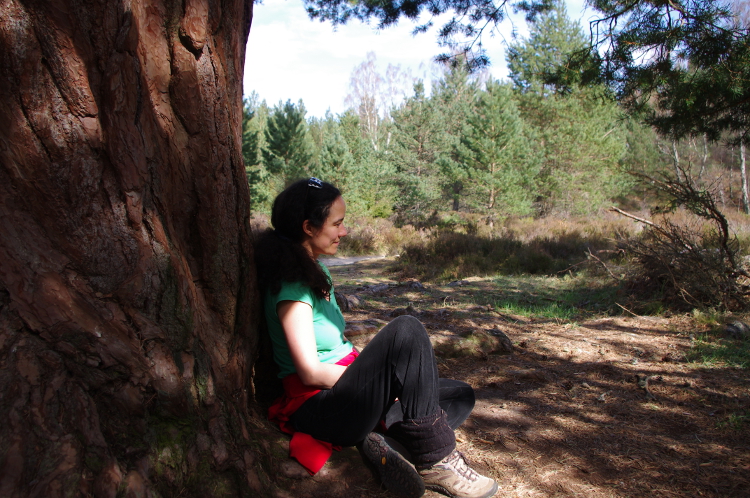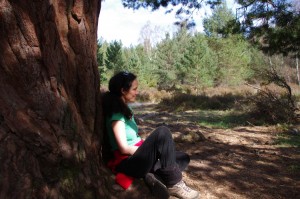
Ludwig Appeltans has included a circular economy into the design for the nature-based permaculture community he created on the Isle of Skye. If you want to hire him or learn from him, please feel free to join the Virtual Village.
On the Village you can join in with the nature connection program the community is running!
Since Permaculture is designing efficient systems in harmony with our ecosystem, we obviously need to know what that ecosystem truly looks like. There is only one way: through observation: The Sit Spot Routine.
Sit spot in a nutshell: Find one place in or near your permaculture project and get to know it as your best friend. Let this be a place where you learn to sit still – alone, often and quietly – before you playfully explore beyond. This will become your place of intimate connection with nature. The sit spot is the heart of observation routine. It is the magic pill if there ever was one.

Observation is at the core of a good permaculture design. Every garden, every location is different. There are so many influencing factors that make every location unique. Be it the amount of sun, shade, wind or water it receives, the local wildlife, the patterns, the soil, the microclimates, elevation, neighbours … Most of all, the people who are central to a permaculture design are different. With different needs or wants or visions. I hope it is clear that copy and paste permaculture does not work. There are many ways to gather all the data we permaculture designers need to make a good permaculture design. Interviews, check lists, soil tests, maps, etc. But one method sticks out with head and shoulder above all the others: The Sit Spot routine.
The routine is really simple. Most of us have all done it before, often as a child. Find a space where you feel comfortable just being there, still and quiet. In this place the lessons of nature will seep in. The sit spot will become more personal because it feels private and intimate; the place where you will meet your curiosity, the place where you feel wonder, a place where you go eye to eye with a diversity of life forms and weather patterns, the place where you face your fears- of bugs, of being alone, of the dark – and grow past them; and the place where you meet nature as your home.
The essential attitude of this routine is getting to know one place really well, the communities of living organisms, the trees, the animals, the birds and the weather systems – at all times of the day and night and in every season and weather. In other words, the place becomes your nesting niche, your study site, your observation playground, your retreat and renewal centre. The sit spot itself becomes the home base from which you explore outward – where you leave your upright human self behind and crawl on your hands and knees to sniff and feel around. The place will feel of familiarity, relationship, and in-depth knowledge, and when you go to it your attitude overflows with childlike curiosity and uninhibited playfulness.
Sit still and observe as long as you can, preferably at least 15 minutes, preferable for half and hour or longer. It takes a little while for baseline to return, for animals to feel safe again to come out and continue with their daily routines. Use all your senses: your vision, hearing, touch, taste and smell. If you are intuitive, use can use that too.
The other part to this routine is about sitting, about stillness. On the simplest level, to sit silent and still for a long period of time will slip open the door of a world that most humans never know: the private world of wild animals and the language of birds. Sunset and sunrise are especially magical times, when wildlife actively pulses with life. Once you sit quietly long enough, the birds sort of shrug you off and accept the fact that you are there and there for good. As they return to their daily tasks, a previously hidden dimension of your landscape opens up.
The clever wild animals know the patterns of human activity and move out to its edge to go unseen. Sitting still initiates you into their undomesticated realm, a wild place that plays by different rules than the human world. By being a quiet, unobtrusive guest, you will get to know Baloo’s jungle law and learn to make yourself welcome again, as an accepted member of the natural community.

Finding the right spot. I recommend you find a spot not too far away from your home, preferably near water, shelter or food for wildlife, that you can easily get to without doing damage to a fragile garden and encounter little hazard. This can be found almost anywhere. Be it in a corner, under a tree, or on the porch looking at the bird feeder. In cities it can be a park or a rivers edge. It is not about the quality of the spot, it is about the quality of attention within it. If you can’t find the spot you love, love the one you’re with.
Owl eyes and fox walk: Try to go to the spot without drawing attention to yourself. Walk slow, try not to crack any twigs, don’t make sudden movements. Just walk like a fox, don’t sneak, wild animals have a 6th sense for that and it scare them.
Once in your spot, practise your owl eyes. Try to train your entire vision to function. Try to counter act the focussing we have trained our eyes to do. While looking straight ahead, focus your attention on what is happening in the corner of your eyes.
Cultivate your child-like curiosity. It is your own curiosity that will the driver of your learning journey.
It is a meeting with nature, a building of a relationship. As you get to know your spot, your spot will get to know you too. The animals will start recognising you as a harmless common feature and after a while, the waiting times for baseline to return will get shorter as the life in your spot recognises and accepts you as part of the community and that pose no threat.
After each sit spot exercise, take some time to take notes. First describe the circumstances, the time of day, the weather and anything that you think could have influenced the behaviour of the animals. Note down your observations. Writing them down helps to remember them, but it also helps to confirm patterns. This is important as it is the patterns that will influence our permaculture design the most.
Be aware that no matter how quiet or peaceful you are in your spot, you will always influence your ecosystem, just by being there. Sit spotting is the most powerful way to observe, but there are other techniques too. The best way to observe what happens in your system, when you are not present, is bird language and tracking.
Once you go to your sit spot on a regular basis, the learning journey takes on a life of its own. Enjoy.
Observation skills are a really important part of the Permaculture design Curriculum on the Design courses that Ludwig teaches. Feel free to check the events calender to learn more about the courses.
If you’d like, please share your observations in a comment below.
From Jon Young’s teachings. Inspired by his book: “Coyote’s guide to connecting with nature.”
Adapted for permaculture by Ludwig Appeltans.
Ludwig Appeltans has included a circular economy into the design for the nature-based permaculture community he created on the Isle of Skye. If you want to hire him or learn from him, please feel free to join the Virtual Village.
On the Village you can join in with the nature connection program the community is running!
